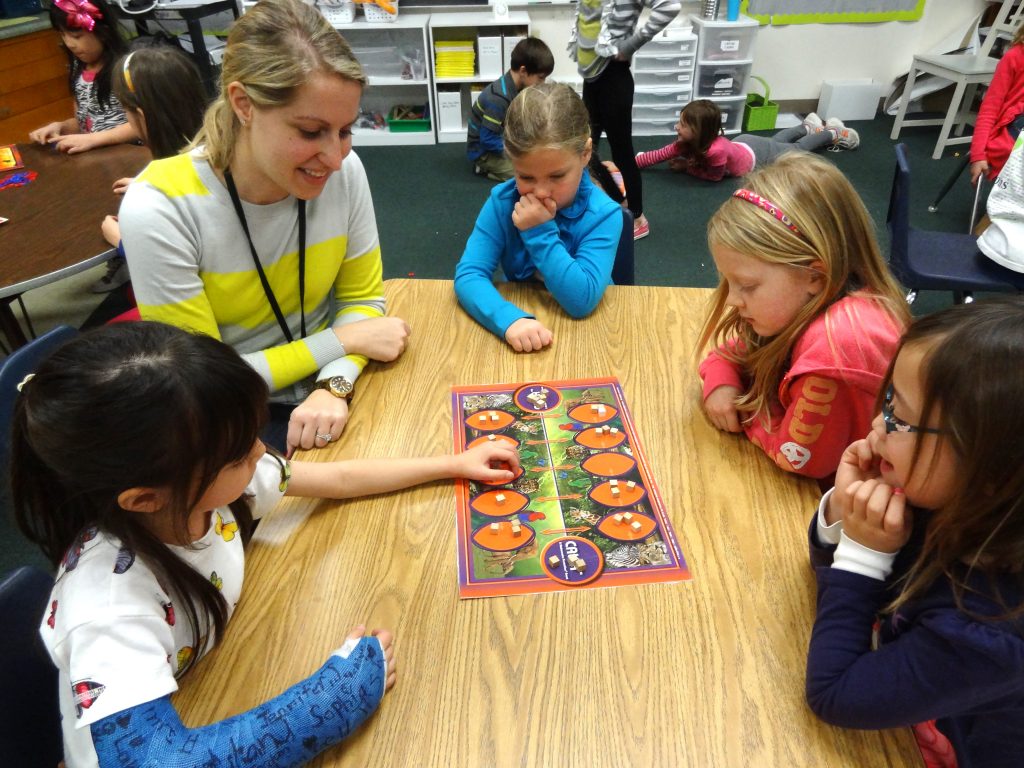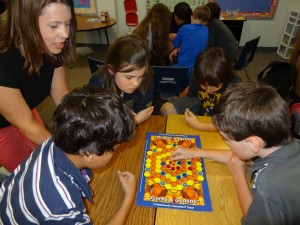The Mathematics Pentathlon® Program may be implemented in a variety of instructional formats including classroom, club, home and academic tournaments. Two or three formats may be used simultaneously or only one setting may be chosen. Maximum benefits are derived when all four instructional formats are functioning.

The Mathematics Pentathlon® Program encourages the use of strategic games as an integral part of instruction. It fosters cooperative learning by having students listen to and support each other in learning the games. The use of The Games and the instructional activities found in Adventures in Problem-Solving Activity Books I and II, Investigation Exercises Books I and II, and The Teaching Guides improves students’ abilities to: communicate their ideas effectively; critically listen to others’ ideas; offer creative and varied alternatives to problem situations; and develop critical problem-solving characteristics of flexibility, persistence and inventiveness. The most effective use of the Mathematics Pentathlon Program is to organize students into cooperative groups (think tanks) of four and teams of two students. While playing these games, each team openly discusses various options and strategies so that all group members can listen. This technique enables all students to mature in their understanding of a game’s variables and strategies. Heterogeneous grouping is suggested. This allows students of varying abilities and learning styles to help each other by sharing their different perspectives. The Mathematics Pentathlon Program stresses critical and reflective thought rather than reflective, rapid responses. Students should be encouraged to examine alternatives to a game situation and select a reasoned option. Although knowledge of the Mathematics Pentathlon® Games basic facts and concepts is relevant to some of the Mathematics Pentathlon games, it is the strategic use of that knowledge that is essential.
 While using the Pentathlon Games, teachers are encouraged to move from group to group and ask students questions about the choices they have made. By doing so, teachers diminish the impulsive tendencies of students. This helps them to become more reflective rather than reflexive. To create an environment of constructive competition, teachers ask opposing team members to shake hands and wish each other good luck when beginning a game. Likewise, at the end of each game, opposing team members are again encouraged to shake hands to demonstrate their appreciation for each team’s efforts in “giving it their best shot.” Since the games deal with a wide range of mathematical thought including spatial/geometric, computational and logical/scientific reasoning, the games are ideal for a wide range of abilities and learning styles. All students should be provided with opportunities to experience the Pentathlon Games and encouraged to develop their problem-solving abilities. We suggest that teachers do not use the Mathematics Pentathlon games to: offer these experiences only as a reward to those students who have completed their textbook and/or paper and pencil assignments; provide only one-on-one experiences with games; occupy students’ time so that a teacher can grade papers or perform other duties; or stress the competitive win-loss aspects of a game.
While using the Pentathlon Games, teachers are encouraged to move from group to group and ask students questions about the choices they have made. By doing so, teachers diminish the impulsive tendencies of students. This helps them to become more reflective rather than reflexive. To create an environment of constructive competition, teachers ask opposing team members to shake hands and wish each other good luck when beginning a game. Likewise, at the end of each game, opposing team members are again encouraged to shake hands to demonstrate their appreciation for each team’s efforts in “giving it their best shot.” Since the games deal with a wide range of mathematical thought including spatial/geometric, computational and logical/scientific reasoning, the games are ideal for a wide range of abilities and learning styles. All students should be provided with opportunities to experience the Pentathlon Games and encouraged to develop their problem-solving abilities. We suggest that teachers do not use the Mathematics Pentathlon games to: offer these experiences only as a reward to those students who have completed their textbook and/or paper and pencil assignments; provide only one-on-one experiences with games; occupy students’ time so that a teacher can grade papers or perform other duties; or stress the competitive win-loss aspects of a game.
Teachers are encouraged to initiate certain games with only a partial number of rules in operation and to add additional rules as students begin to demonstrate a knowledge of those already given. Each of the Division Guides for Teaching and Sequencing the Mathematics Pentathlon® Program organizes instruction so that 1) rules are introduced in a developmentally appropriate manner, and 2) essential prerequisite activities from the Adventures in Problem Solving Book and follow-up analysis from the Investigation Exercises Binder are implemented to maximize students problem-solving skills. Organized into weekly lesson plans, each Guide provides an exciting format for teaching the Mathematics Pentathlon® Program while also allowing teachers to customize the program to fit their individual classroom needs.